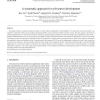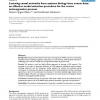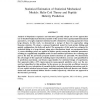13 search results - page 2 / 3 » A Shrinkage Approach for Modeling Non-stationary Relational ... |
BMCBI
2007
13 years 5 months ago
2007
Background: Microarray techniques survey gene expressions on a global scale. Extensive biomedical studies have been designed to discover subsets of genes that are associated with ...
CCE
2007
13 years 5 months ago
2007
This paper presents a systematic approach based on robust statistical techniques for development of a data-driven soft sensor, which is an important component of the process analy...
WWW
2010
ACM
14 years 6 days ago
2010
ACM
Previous work analyzing social networks has mainly focused on binary friendship relations. However, in online social networks the low cost of link formation can lead to networks w...
BMCBI
2007
13 years 5 months ago
2007
Background: Causal networks based on the vector autoregressive (VAR) process are a promising statistical tool for modeling regulatory interactions in a cell. However, learning the...
JCB
2007
13 years 5 months ago
2007
Analysis of biopolymer sequences and structures generally adopts one of two approaches: use of detailed biophysical theoretical models of the system with experimentally-determined...



